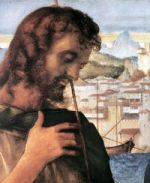Catholic Activity: Customs and Traditions of St. Christopher, July 25
From Father Francis X. Weiser, S.J.'s Handbook of Christian Feasts and Customs. Discusses some of the traditions and customs related to the feast of St. Christopher, martyr.
DIRECTIONS
Only the name of this saint and the fact of his martyrdom are known. His veneration was widespread in both the Eastern and Western Churches in early centuries. He is supposed to have died in Palestine or Lebanon (Canaan). But very early, too, legends supplied with abundant fantasy what history could not provide, and all kinds of startling details were told about him.10 He was a giant of no mean proportions; it took four hundred soldiers to take him captive; for twelve hours his body was pierced with arrows until he fell to the ground, but even then he was still alive and had to be beheaded.
Later legends added many other details to the story of his life and conversion. The most familiar one is told in the thirteenth-century Golden Legend. Proud of his giant stature, a man, whose original name was Offerus, decided to serve only the strongest lord in the world. He entered the service of the emperor; but on seeing that the emperor was afraid of the Devil, he forthwith served the Devil. One day he saw how the Devil trembled at the sight of a crucifix, so he decided to serve Christ. A hermit told him he should carry Christian pilgrims through a deep and dangerous river. He did so. One night a little boy asked to be carried across. The giant took the little one on his shoulders and started across the churning waters. But as the child on his back grew heavier and heavier Offerus felt that he would break down under the burden. When he reached the other shore, panting and exhausted, he asked in surprise why the child was so heavy. He received the answer: "You have not only carried the whole world on your shoulders but Him Who created it. I am Christ the Lord, whom you serve." Then the Lord Himself took Offerus into the water, baptized him, and gave him the new name "Christophorus" (Christ-bearer). He told the saint to ram the tree trunk that he carried as staff into the ground. Christopher did so, and the tree immediately burst forth with leaves and blossoms. The Child had disappeared, and the saint went joyfully to persecution and death for his beloved Lord.
This beautiful legend captivated the hearts of the faithful everywhere and was the inspiration for many devotions. Saint Christopher was venerated as patron against sudden and unprovided death, especially during times of great epidemics, when people never knew in the morning whether they would still be alive that evening. They believed that by looking at his picture and saying a prayer to him in the morning they would be safe from death on that day. So they hung his picture over the door of the house, or painted it on the walls outside, to give others the benefit of it, too.
This tradition has been kept in central Europe to the present day, although its meaning has been forgotten by many. Any tourist traveling through southern Germany, Switzerland, Austria, and France will notice the large images of Saint Christopher painted on the outside of houses and churches.
Christopher is the patron of ferryboats and their crews, of pilgrims and travelers, of gardeners (because his staff burst into bloom), and of freight ships. In France all fortresses were put under his protection in centuries past. In England he was invoked against hail and lightning. Since he carried our Lord safely through the waters, he became the patron of all passenger traffic, especially in automobiles. In many countries cars are blessed on his feast day. At churches that bear his name the blessing is usually given in a more solemn way on his feast, and hundreds of automobiles line up in front of the shrine to receive the blessing for that year.
More recently Saint Christopher has also been venerated as the patron of skiing, and appropriately so. Having carried the Christ Child through the waters, he gladly protects children and grownups gliding over the snow. It was a coincidence, but perhaps somewhat providential as well, that the town in the best and most famous ski territory in Austria is named Saint Christopher (Sankt Christoph am Arlberg).
Finally, there are the Saint Christopher medals and plaques, which people have blessed by a priest to carry on their persons as a protection against accidents. These medals are now also put in cars and other vehicles and are popular with Christians of all faiths. The custom of using such images of the saint started in the sixteenth century, and their original purpose was to serve as a picture for travelers to gaze on every morning and ask God to save them from sudden death that day. This custom has died out long since but the medals have remained as a token of the saint's generous help and protection in modern traffic, which kills almost as many people as epidemics did in ancient times.
LITURGICAL PRAYER — Grant us, O Lord, almighty God, as we celebrate the birthday of Saint Christopher, Thy Martyr, that through his intercession we may be strengthened in the love of Thy holy Name.
Activity Source: Handbook of Christian Feasts and Customs by Francis X. Weiser, S.J., Harcourt, Brace and Company, New York, 1958






